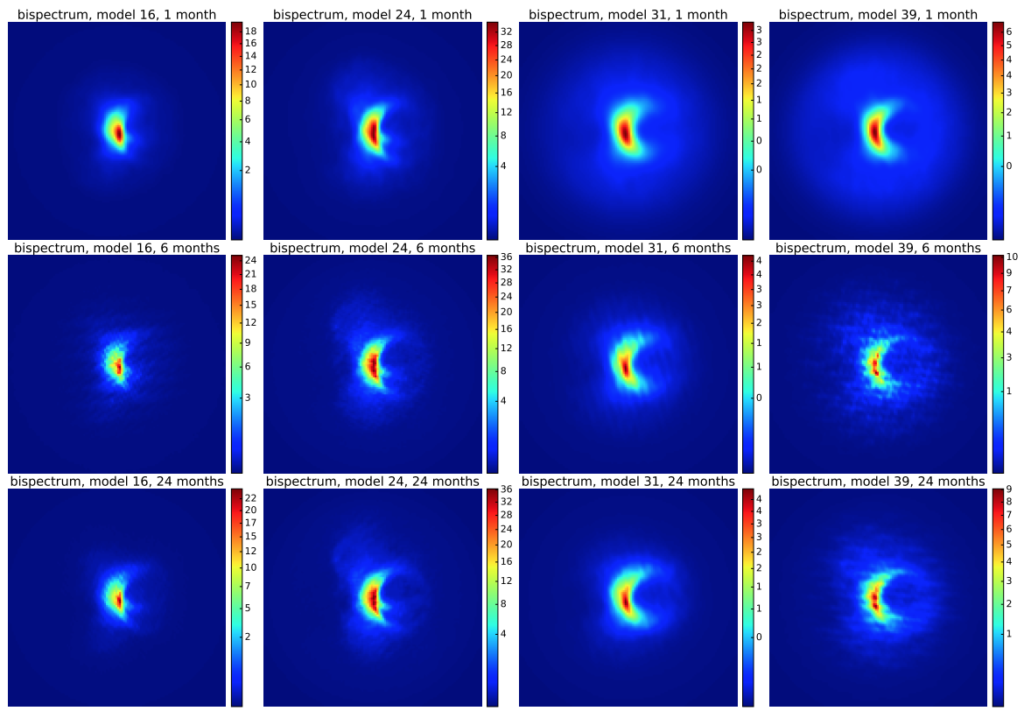Title: Simulations of imaging the event horizon of Sagittarius A* from space
Authors: Freek Roelofs, Heino Falcke, Christiaan Brinkerink, Monika Mościbrodzka, et al.
First Author’s Institution: Department of Astrophysics, Institute for Mathematics, Astrophysics and Particle Physics, Radboud University
Status: Accepted for publication in Astronomy & Astrophysics; open access on the arXiv
Laying the groundwork for imaging black holes
Earlier this week, scientists from the Event Horizon Telescope (EHT) collaboration released the first ever images of a black hole’s shadow. Although the collaboration observed two sources — a supermassive black hole (SMBH) at the center of the galaxy Messier 87 (M87), and Sagittarius A* (Sgr A*, pronounced “Sag. A-star”), the SMBH at the heart of our own — the results released were of M87. The SMBH in M87 was targeted because of its enormous mass, but in order to see its shadow directly, an Earth-sized telescope would have to observe it at a frequency of 230 GHz (1.3 mm wavelength) or higher.
In order to build a telescope effectively the size of the Earth, the EHT collaboration used a technique called Very-Long-Baseline Interferometry (VLBI). Through VLBI, signals from the same source are collected at multiple radio telescopes; using the time difference between the arrival times of the signals at different observatories, the observed radiation is then correlated between every pair of telescopes to produce extremely high-resolution observations. On and off over multiple days in April 2017, many radio observatories across the world observed as one effectively Earth-sized telescope, an exceptional testament to the power of scientific collaboration. As impressive as this achievement already is, some scientists are already looking to take VLBI imaging of black holes to the next level: space.
The sky’s (not) the limit
The authors of today’s paper released a concept study of a space-based VLBI (SVLBI) experiment called the Event Horizon Imager (EHI), a nod to the success of EHT. SVLBI operates similarly to traditional ground-based VLBI, with the main difference being that the radio telescopes are satellites in space. The preliminary design for EHI involves two or three satellites in Medium-Earth Orbit at slightly different radii (~14,000 km) and thus orbiting at slightly different speeds, allowing for coverage that would enable high-precision image reconstructions.
With the telescopes purely in space, as opposed to on Earth, observations would be unhampered by the reduction of signals after traveling through the Earth’s atmosphere, the severity of which increases with increasing frequency. As such, EHI would be able to observe radio sources such as Sgr A* at higher frequencies, up to ~690 GHz (~0.43 mm wavelength). At higher frequencies, the angular resolution of the image would also increase, and the signals would generally originate from closer to the black hole, reducing image variability.
What would an EHI image look like?
There are many engineering improvements necessary before a mission like EHI could exist, including improving position determination via satellites at higher altitudes. Acknowledging the technical challenges involved with SVLBI, the authors choose to take the challenging parameters as a given so that they could explore the imaging capabilities of such a mission. To do so, first they used general relativistic magnetohydrodynamics (GRMHD) simulations of Sgr A*. (Magnetohydrodynamics simulations are explained a bit more in this astrobite; general relativity effects are incorporated in GRMHD simulations as well.) Using these simulations, they then simulated observations of (the simulated) Sgr A* using various EHI parameters to see what type of images they could obtain.
The main parameters explored were the size of the radio dishes on the satellites and the number of satellite dishes (2 or 3). As can be seen in Figure 1, using the 25 m radio dishes (bottom row of images) would result in much better image resolution than using the 4.4 m dishes (top row of images). The 25 m radio dishes would have an image resolution of 4 microarcseconds, which is about an order of magnitude better than what has been accomplished by EHT so far. However, launching a 25 m dish is enormously unlikely to happen within the next few decades. (The James Webb Space Telescope has a sunshield under 22 m in length – about the size of a tennis court!)

Launching three satellites would greatly increase the cost and data complexity of a SVLBI mission compared to two satellites. By using something called the bispectrum (the product of the complex visibilities of the three baselines of a triangular radio interferometer), the image resolution of three 4.0 m dishes would be better than the image resolution of two 4.4 m dishes (Figure 2).
However, this result comes with the caveat that here the GRMHD simulation used was a time-averaged model, as if a static source were being observed. Assuming the source is static over certain lengths of observations would be more relevant for M87, which is variable at time scales nearly a thousand times longer than Sgr A*. For Sgr A*, using three 4.0 m dishes to observe it as a time-variable source (a more realistic model) would result in worse image resolution than using two 4.4 m dishes (Figure 3), as using the bispectra alone for three satellites is not enough to reconstruct a static image with the same quality as using two satellites.


Looking ahead
With the spectacular results from EHT, Einstein’s theory of general relativity passed yet another test. An SVLBI mission such as EHI would be able to put general relativity to even more extreme tests, and we could also begin looking for other exotic objects such as boson stars. Although there are many technical challenges associated with launching SVLBI missions, concept studies such as EHI show that SVLBI missions might just lead the way for tomorrow’s images of black hole shadows.



